by Shopify Writer Dan Wang
14 minute read
Want more traffic and more sales for your online store? Of course you do. That’s why we put together 13 marketing tactics – with the tools to implement each of them – for you to put into action today.
If you’re wondering whether you’re doing the most you can to get as many visitors to your store as possible, then this is the post for you. The tactics we’ve put together range from triggering a special discount just as a customer is about to exit from your store, to creating emails for customers who have placed items in their shopping carts but failed to complete the purchase.
So here’s a fun idea: Implement one of these tactics every single day over the next two weeks. And on the last day of this two-week sprint, evaluate, take stock, and figure out what worked best for you.
Get ready to get new visitors, get more out of current visitors, and get back lost visitors today.
Most of us have heard some form of that question. It’s an example of upselling, or the effort of merchants to sell you a slightly more expensive product when you consider a product.
And guess what? It works. According to Econsultancy, upselling is 20 times more effective than cross-selling online. Sometimes your customers don’t know that a better product is available, or they may be convinced that a different product may be a better fit for their needs.
Are one of your products made of slightly better leather? Or carry a special component that’s handmade? Make sure to emphasize the difference, and ask if the customer might be convinced to make an upgrade.
There are two keys to upselling: 1) Making your upsells related to the original product, and 2) Being sensitive to the price range of your customers. Just keep in mind that your product has to fit the original needs of your customer, and that they may not be very enthusiastic about a higher product price once they have an anchor price in mind. The new product must really be better than the original.

 The Product UpSell app gives you the ability to offer a different
product during checkout based on the contents of the shopping cart of
your customers. Integrate it with your store to sell one or many
higher-margin products. You can also customize it to make an offer only
if the contents of the cart exceeds a certain dollar amount. Finally,
you can use it to run promotions like: “Buy One and Get One Free.”
The Product UpSell app gives you the ability to offer a different
product during checkout based on the contents of the shopping cart of
your customers. Integrate it with your store to sell one or many
higher-margin products. You can also customize it to make an offer only
if the contents of the cart exceeds a certain dollar amount. Finally,
you can use it to run promotions like: “Buy One and Get One Free.”
In addition, a recent study has found that Instagram gives brands 25% more engagement than any other social media platform.
If you use the right hashtags, appropriate filters, and post at the right times, then you’re well on your way to building a big following on Instagram. The key to mastering Instagram marketing is engagement with your users.
What are some ways to engage with your audience? You may try out running campaigns or contests, going behind the scenes for your products, and most importantly, showing pictures of your customers using your products. These are called user-generated photos, and they’re an excellent way to demonstrate that to potential customers that you have happy current customers.
User-generated photos are a great way to generate social proof. Prospective customers see that your products are regularly being purchased people just like them, and feel more comfortable doing something that others are doing.
So keep building your Instagram following and engage more with them.
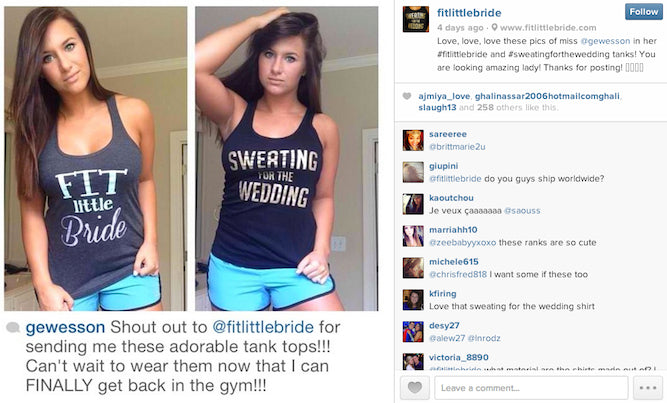
 Instagration is an excellent tool for increasing Instagram
engagement. It integrates with your online store, and gives you the
ability to moderate the Instagram pictures of your customers and display
them in different formats. It’s an excellent tool to increase
engagement with new customers by showing that you like to feature your
current customers.
Instagration is an excellent tool for increasing Instagram
engagement. It integrates with your online store, and gives you the
ability to moderate the Instagram pictures of your customers and display
them in different formats. It’s an excellent tool to increase
engagement with new customers by showing that you like to feature your
current customers.
The phenomenon is a well-studied one: Customers add items to their carts but abandon their carts during checkout. According to the Baymard Institute, 67.45% of shopping carts are abandoned before they’re completed. Think about that for a minute. Your sales are one-third of what they may potentially be.
It’s worth the effort to resolve as many hesitations as you can, because a significant percentage of those who abandoned their carts may yet be convinced to complete their purchase. Perhaps they can be persuaded with a discount, or the offer of free shipping, or maybe they never even meant to exit from their cart in the first place because their computer crashed.
One simple and effective way to reduce the incidence of abandoned carts? An email recovery campaign to convince your customers to complete their purchase.
So go ahead. Craft a good email that entices your customer to return to their cart. You can do this directly in the Shopify admin, and we also recommend an app below.

 Abandon Aid lets you send a note to a customer who abandons her cart
to remind her of her order and to ask her to complete it. It’s simple
and automatic: No need for manual triggers.
Abandon Aid lets you send a note to a customer who abandons her cart
to remind her of her order and to ask her to complete it. It’s simple
and automatic: No need for manual triggers.
As you can see from Shopify’s infographic on social media marketing, Facebook takes the lion’s share of the orders placed from social media marketing.
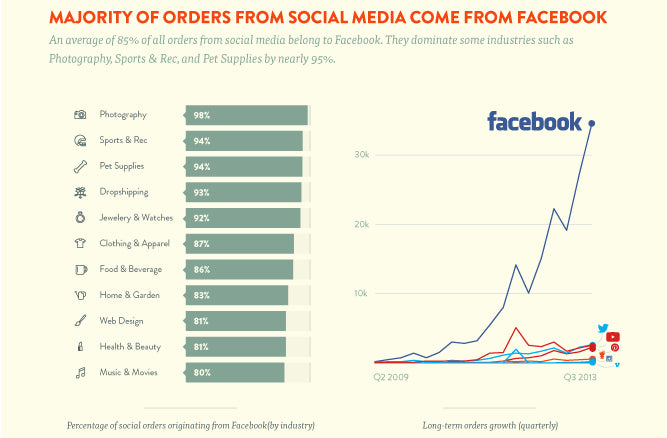
Well guess what? Facebook isn’t just a great source of traffic. You can also sell directly on Facebook with a Facebook Store.
It’s easy to set up, and a great channel for making sales. Even better, it integrates directly with your Shopify store, so you don’t have to keep a separate track for inventory changes.
Make it easier for customers to reach you on the biggest social media platform in the world.
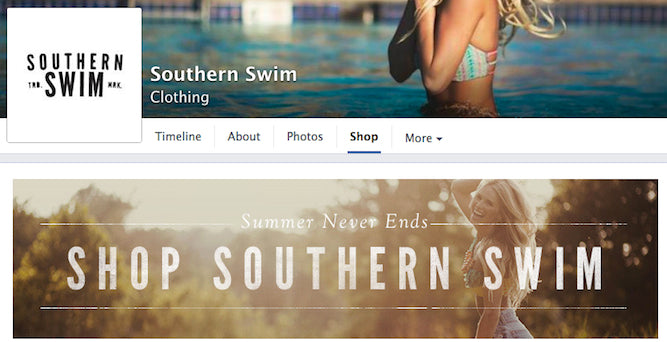
 Facebook Store is an app developed by Shopify that lets you showcase
and sell products directly on your Facebook Page. Customers can share
their favorite products with their friends. One cool feature:
Like-gating, which permits only the users who have “liked” your Facebook
page to view your store.
Facebook Store is an app developed by Shopify that lets you showcase
and sell products directly on your Facebook Page. Customers can share
their favorite products with their friends. One cool feature:
Like-gating, which permits only the users who have “liked” your Facebook
page to view your store.
Email marketing works. Want some data? According to recent research and surveys:
Be active about promoting your newsletters to get as many subscribers you can on a high-converting channel.

 Email Pirate allows you to create a fully-customizable opt-in window
that pops up to encourage your visitors to subscribe to your emails. You
can download this list of customers into a spreadsheet, and upload it
to your email client. It also gives you the ability to track user
behavior so that you can segment your customers based on their behavior
prior to opting in.
Email Pirate allows you to create a fully-customizable opt-in window
that pops up to encourage your visitors to subscribe to your emails. You
can download this list of customers into a spreadsheet, and upload it
to your email client. It also gives you the ability to track user
behavior so that you can segment your customers based on their behavior
prior to opting in.
For example, send out a welcome email as soon as a customer signs up. These have among the highest open rates of any marketing emails.
Or, write an email to let your customer know that his order is being processed and is on the way out. He’d love to know that what he ordered will be arriving soon.
One more example for you: Send out regular newsletters, and let subscribers know of new discount offers, product tips, and fun company news.
For more inspiration, check out our list of email campaigns that you can steal today.

 Emma gives you the ability conduct better marketing campaigns by
targeting your customers with the right message based on purchase
history. Segment, for example, along high-value customers, or recent
customers. You also have the ability to automate thank-you and rewards
emails. Finally, you can track the purchases that resulted from your
emails, so that you can instantly assess the value of a particular
email. Emma is a great tool for designing, delivering, and analyzing
your email campaigns.
Emma gives you the ability conduct better marketing campaigns by
targeting your customers with the right message based on purchase
history. Segment, for example, along high-value customers, or recent
customers. You also have the ability to automate thank-you and rewards
emails. Finally, you can track the purchases that resulted from your
emails, so that you can instantly assess the value of a particular
email. Emma is a great tool for designing, delivering, and analyzing
your email campaigns.
The Wishlist Reminder Email is closely related to its cousin, the Abandoned Cart Email. Both are supposed to convince you take the final step in purchasing the product that you’ve had the intent to buy.
Has it been a while since someone has checked in on his wishlist? Have an item on sale that’s been put into a lot of wishlists? Will it soon be sold out? Send out an email to let your customer know.
It may just be the trigger they need to purchase the item.

 The Wishlist + Reminder app is an easy way to automate wishlist
emails. You can customize the look and feel of the wishlists on your
site, then send emails out to people to remind them that there’s
something in your store that they like, and also to send emails whenever
you list a product in their wishlist to be on sale.
The Wishlist + Reminder app is an easy way to automate wishlist
emails. You can customize the look and feel of the wishlists on your
site, then send emails out to people to remind them that there’s
something in your store that they like, and also to send emails whenever
you list a product in their wishlist to be on sale.
What exactly does it mean for your store to be badly designed? Besides looking untrustworthy, your store could be suffering from some combination of the following: lacking a clear value proposition, not writing good product descriptions, and difficult navigation.
And even when you’ve improved every dimension above, you could still be committing some ecommerce design mistakes. Are you properly segmenting your products or are you putting too many products on a page? Have you figured out the right balance between text and visuals? These are all things that you should consider.
There are lots of ways for you to improve your store. If your theme isn’t really converting well for you, take a look at some of the other great themes on offer from Shopify.
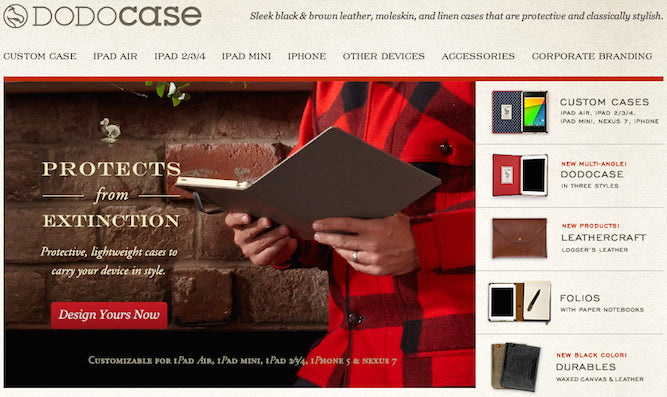
 Sometimes even when you’ve perfected the design of your store, you
could still be losing customers who feel, for example, that your prices
are too high. Enter Exit Offers. When customers move their mouse to
close out of your store, you can make a special offer pop up, to offer
for example a discount or free shipping. You can also track the success
of this app. It also gives you the chance to A/B test different
messages.
Sometimes even when you’ve perfected the design of your store, you
could still be losing customers who feel, for example, that your prices
are too high. Enter Exit Offers. When customers move their mouse to
close out of your store, you can make a special offer pop up, to offer
for example a discount or free shipping. You can also track the success
of this app. It also gives you the chance to A/B test different
messages.
Why? For two reasons:
First, social proof: Product reviews are a form of testimonials. You see immediately what people are saying about a product that you’re considering purchasing.
Second, SEO: Having product reviews increases the amount of content on a page and also increases the probability that you hit a few long tail keywords.
For both these reasons, adding product reviews increase sales.
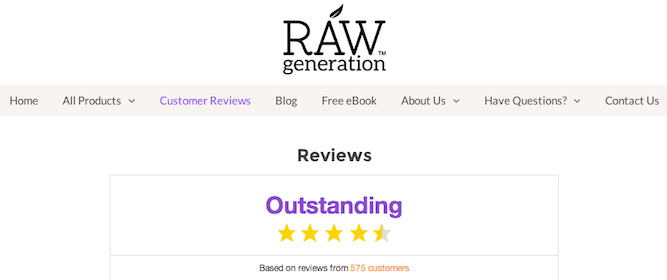
 Product Reviews is a free app designed by Shopify that offers an easy
way to add reviews to your store. It’s fully-customizable and includes
theme-adaptive design.
Product Reviews is a free app designed by Shopify that offers an easy
way to add reviews to your store. It’s fully-customizable and includes
theme-adaptive design.
One of the best ways to attract qualified visitors is by using Google AdWords to get your store to show up in Google when people search for your keywords.
After advertising on Google, try out advertising Facebook. Consider that Robert Nava of National Parks Depot spent $60 and got nearly $1000 in sales on the very first day. We’re not saying that his success is easily replicated, but Facebook advertising is not something that you should ignore.
Play around and see what kind of ads work for you.

Ad spending is tricky, but Vantage will help you improve your ads to save money and get better results. Instead of a fixed fee, Vantage charges up to 15% to auto-optimize your campaigns.
For example, you could direct your visitors to your social media profiles. Do you have a gorgeous Instagram feed? Are you actively managing your Facebook page? Make these “follow” buttons more prominent on your homepage.
Feature your blog more actively. Every ecommerce store should be blogging regularly, to connect with fans and to rank better for SEO.
And also, why not try offering promotions on your products? Everybody loves a special sale.
What’s one way to do all of these more effectively? Try using an on-site pop-up to capture emails, link to your social media profiles, or promoting a product.
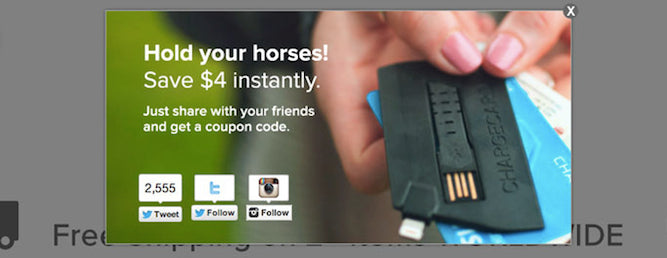
 Justuno increases sales conversations by automating pop promotional
offers and exit offers. It can also pop up to encourage your visitors to
follow you on your social media networks.
Justuno increases sales conversations by automating pop promotional
offers and exit offers. It can also pop up to encourage your visitors to
follow you on your social media networks.
You can do that by keyword research, geographic validation, and looking at social media trends.
One more creative way to test out your market?
Pre-selling items, or listing them as out of stock, and see how many people place sales.
That’s right, if you’re considering selling one out of three items, create pages for all of them (with good photography and appropriate text), and place them up on your store. Then list them as “out of stock” and see simply which ones get the most attention in terms of orders placed and requests to be notified when you restock. That’s the one to sell.
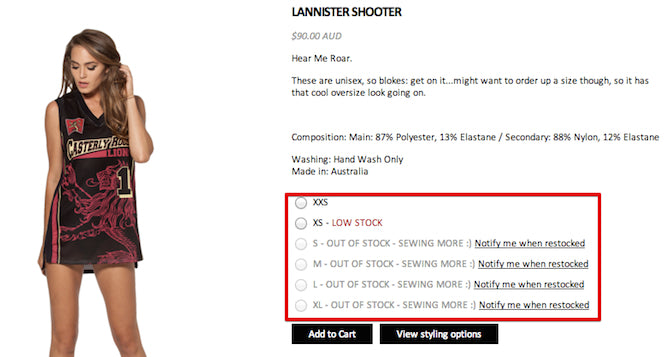
 Manage pre-orders before you have it in stock with Out of Stock. Just
ship it to your customer once it becomes available. Set it up for
pre-order or when you’re waiting to re-fill your stock.
Manage pre-orders before you have it in stock with Out of Stock. Just
ship it to your customer once it becomes available. Set it up for
pre-order or when you’re waiting to re-fill your stock.
Consider LuxyHair, which built its business through Youtube marketing.
Or Raw Generation, which generated sales by exploiting deals websites.
And finally, BeardBrand, which managed to tap into the needs of a community: In this case, men who are big into grooming their beards.
Come up with your own tactic, and share it below in the comments. It can be big or small. Our first entry? Try integrating gift registries into your store. You can get lots of referrals and sales if you have a wide selection of products that may be appropriate as gifts. Plus, it offers higher margins as well. But that’s just one suggestion.
 Gift Reggie is a nifty tool for creating custom wish lists that may
be especially useful as gift registries. Customers can take these
registries to share with friends and family. Why not give your customers
one more option for sharing your store with your networks?
Gift Reggie is a nifty tool for creating custom wish lists that may
be especially useful as gift registries. Customers can take these
registries to share with friends and family. Why not give your customers
one more option for sharing your store with your networks?
(PS Here’s a list of the top 20 most popular free Shopify apps.)
Let us know in the comments which of these tactics and apps worked out especially well for you.
Photo credit: Matthias Clamer/Getty
14 minute read
Want more traffic and more sales for your online store? Of course you do. That’s why we put together 13 marketing tactics – with the tools to implement each of them – for you to put into action today.
If you’re wondering whether you’re doing the most you can to get as many visitors to your store as possible, then this is the post for you. The tactics we’ve put together range from triggering a special discount just as a customer is about to exit from your store, to creating emails for customers who have placed items in their shopping carts but failed to complete the purchase.
So here’s a fun idea: Implement one of these tactics every single day over the next two weeks. And on the last day of this two-week sprint, evaluate, take stock, and figure out what worked best for you.
Get ready to get new visitors, get more out of current visitors, and get back lost visitors today.
1. Upsell Your Products
“May I interest you in this upgrade?”Most of us have heard some form of that question. It’s an example of upselling, or the effort of merchants to sell you a slightly more expensive product when you consider a product.
And guess what? It works. According to Econsultancy, upselling is 20 times more effective than cross-selling online. Sometimes your customers don’t know that a better product is available, or they may be convinced that a different product may be a better fit for their needs.
Are one of your products made of slightly better leather? Or carry a special component that’s handmade? Make sure to emphasize the difference, and ask if the customer might be convinced to make an upgrade.
There are two keys to upselling: 1) Making your upsells related to the original product, and 2) Being sensitive to the price range of your customers. Just keep in mind that your product has to fit the original needs of your customer, and that they may not be very enthusiastic about a higher product price once they have an anchor price in mind. The new product must really be better than the original.
Here’s an example of a product upsell:
Take a look at how Apple sells iPads. Basically every option in the red box below represents an effort by Apple to convince customers to switch to an iPad that gives Apple slightly better margins.
Here’s an app to upsell your products:
Product Upsell
 The Product UpSell app gives you the ability to offer a different
product during checkout based on the contents of the shopping cart of
your customers. Integrate it with your store to sell one or many
higher-margin products. You can also customize it to make an offer only
if the contents of the cart exceeds a certain dollar amount. Finally,
you can use it to run promotions like: “Buy One and Get One Free.”
The Product UpSell app gives you the ability to offer a different
product during checkout based on the contents of the shopping cart of
your customers. Integrate it with your store to sell one or many
higher-margin products. You can also customize it to make an offer only
if the contents of the cart exceeds a certain dollar amount. Finally,
you can use it to run promotions like: “Buy One and Get One Free.”2. Integrate Instagram
The average order value from Instagram marketing is $65.00. That’s higher than from any other social media platform except for Polyvore ($66.75).In addition, a recent study has found that Instagram gives brands 25% more engagement than any other social media platform.
If you use the right hashtags, appropriate filters, and post at the right times, then you’re well on your way to building a big following on Instagram. The key to mastering Instagram marketing is engagement with your users.
What are some ways to engage with your audience? You may try out running campaigns or contests, going behind the scenes for your products, and most importantly, showing pictures of your customers using your products. These are called user-generated photos, and they’re an excellent way to demonstrate that to potential customers that you have happy current customers.
User-generated photos are a great way to generate social proof. Prospective customers see that your products are regularly being purchased people just like them, and feel more comfortable doing something that others are doing.
So keep building your Instagram following and engage more with them.
Here’s an example of a piece of user-generated content:
Fit Little Bride, a store that sells work-out clothing for women, has lots of pictures of its customers working out in its products.
Here’s an app to integrate Instagram with your online store:
Instagration
 Instagration is an excellent tool for increasing Instagram
engagement. It integrates with your online store, and gives you the
ability to moderate the Instagram pictures of your customers and display
them in different formats. It’s an excellent tool to increase
engagement with new customers by showing that you like to feature your
current customers.
Instagration is an excellent tool for increasing Instagram
engagement. It integrates with your online store, and gives you the
ability to moderate the Instagram pictures of your customers and display
them in different formats. It’s an excellent tool to increase
engagement with new customers by showing that you like to feature your
current customers.3. Reduce Abandoned Carts
You’re losing money by missing out on potential orders. But don’t take it personally. Every online store is missing out on potential orders.The phenomenon is a well-studied one: Customers add items to their carts but abandon their carts during checkout. According to the Baymard Institute, 67.45% of shopping carts are abandoned before they’re completed. Think about that for a minute. Your sales are one-third of what they may potentially be.
It’s worth the effort to resolve as many hesitations as you can, because a significant percentage of those who abandoned their carts may yet be convinced to complete their purchase. Perhaps they can be persuaded with a discount, or the offer of free shipping, or maybe they never even meant to exit from their cart in the first place because their computer crashed.
One simple and effective way to reduce the incidence of abandoned carts? An email recovery campaign to convince your customers to complete their purchase.
So go ahead. Craft a good email that entices your customer to return to their cart. You can do this directly in the Shopify admin, and we also recommend an app below.
Here’s an example of an effective abandoned cart email:
The folks at Black Milk Clothing aren’t above using a cute puppy and a bold subject line to try to get customers to return to their carts.
Here’s an app to recapture some of the customers who abandoned their carts.
Abandon Aid
 Abandon Aid lets you send a note to a customer who abandons her cart
to remind her of her order and to ask her to complete it. It’s simple
and automatic: No need for manual triggers.
Abandon Aid lets you send a note to a customer who abandons her cart
to remind her of her order and to ask her to complete it. It’s simple
and automatic: No need for manual triggers.4. Launch a Facebook Store
Okay, we’ve talked about Instagram. Now it’s time to talk about Facebook, another big platform for social media marketing.As you can see from Shopify’s infographic on social media marketing, Facebook takes the lion’s share of the orders placed from social media marketing.

Well guess what? Facebook isn’t just a great source of traffic. You can also sell directly on Facebook with a Facebook Store.
It’s easy to set up, and a great channel for making sales. Even better, it integrates directly with your Shopify store, so you don’t have to keep a separate track for inventory changes.
Make it easier for customers to reach you on the biggest social media platform in the world.
Here’s an example of a Facebook store:
Take a look at the Facebook store of Southern Swim:
Here’s an app to integrate your store with Facebook:
Facebook Store
 Facebook Store is an app developed by Shopify that lets you showcase
and sell products directly on your Facebook Page. Customers can share
their favorite products with their friends. One cool feature:
Like-gating, which permits only the users who have “liked” your Facebook
page to view your store.
Facebook Store is an app developed by Shopify that lets you showcase
and sell products directly on your Facebook Page. Customers can share
their favorite products with their friends. One cool feature:
Like-gating, which permits only the users who have “liked” your Facebook
page to view your store.5. Capture More Email Subscribers
Email is one of the best channels at your disposal in online marketing. It drives traffic to your store, supplements content marketing, and outperforms both Twitter and Facebook for generating sales.Email marketing works. Want some data? According to recent research and surveys:
- Email has an ROI of around 4,300% (according to the Direct Marketing Association)
- 80% of people say they receive marketing messages alongside their personal emails on a daily basis.
- 70% of people make use of coupons or discounts they learn about from email.
- 60% of people say that receiving special offers is the top reason they subscribe to an email list from a business.
Be active about promoting your newsletters to get as many subscribers you can on a high-converting channel.
Here’s an example of a prominent email sign-up bar:
Take a look at Huckberry, which is very heavily driven by its email marketing. Huckberry makes signing up for its emails the central feature of its homepage.
Here’s an app to improve the number of your email subscribers:
Email Pirate!
 Email Pirate allows you to create a fully-customizable opt-in window
that pops up to encourage your visitors to subscribe to your emails. You
can download this list of customers into a spreadsheet, and upload it
to your email client. It also gives you the ability to track user
behavior so that you can segment your customers based on their behavior
prior to opting in.
Email Pirate allows you to create a fully-customizable opt-in window
that pops up to encourage your visitors to subscribe to your emails. You
can download this list of customers into a spreadsheet, and upload it
to your email client. It also gives you the ability to track user
behavior so that you can segment your customers based on their behavior
prior to opting in.6. Improve Your Email Campaigns
It’s not enough to capture a bunch of email addresses. You actually have to send them regular emails. There are lots of occasions for sending emails that your subscribers appreciate.For example, send out a welcome email as soon as a customer signs up. These have among the highest open rates of any marketing emails.
Or, write an email to let your customer know that his order is being processed and is on the way out. He’d love to know that what he ordered will be arriving soon.
One more example for you: Send out regular newsletters, and let subscribers know of new discount offers, product tips, and fun company news.
For more inspiration, check out our list of email campaigns that you can steal today.
Here’s an example of an excellent welcome email:
Take a look at this simple and text-driven email from Sycamore Street Press, a family-run paper company based in Utah.
Here’s an app to create better email campaigns:
Emma
 Emma gives you the ability conduct better marketing campaigns by
targeting your customers with the right message based on purchase
history. Segment, for example, along high-value customers, or recent
customers. You also have the ability to automate thank-you and rewards
emails. Finally, you can track the purchases that resulted from your
emails, so that you can instantly assess the value of a particular
email. Emma is a great tool for designing, delivering, and analyzing
your email campaigns.
Emma gives you the ability conduct better marketing campaigns by
targeting your customers with the right message based on purchase
history. Segment, for example, along high-value customers, or recent
customers. You also have the ability to automate thank-you and rewards
emails. Finally, you can track the purchases that resulted from your
emails, so that you can instantly assess the value of a particular
email. Emma is a great tool for designing, delivering, and analyzing
your email campaigns.7. Send Out Wishlist Reminder Emails
One final type of email for your consideration: the Wishlist Reminder Email.The Wishlist Reminder Email is closely related to its cousin, the Abandoned Cart Email. Both are supposed to convince you take the final step in purchasing the product that you’ve had the intent to buy.
Has it been a while since someone has checked in on his wishlist? Have an item on sale that’s been put into a lot of wishlists? Will it soon be sold out? Send out an email to let your customer know.
It may just be the trigger they need to purchase the item.
Here’s an example of a wishlist reminder email:

Here’s an app to send wishlist reminder emails:
Wishlist + Reminder
 The Wishlist + Reminder app is an easy way to automate wishlist
emails. You can customize the look and feel of the wishlists on your
site, then send emails out to people to remind them that there’s
something in your store that they like, and also to send emails whenever
you list a product in their wishlist to be on sale.
The Wishlist + Reminder app is an easy way to automate wishlist
emails. You can customize the look and feel of the wishlists on your
site, then send emails out to people to remind them that there’s
something in your store that they like, and also to send emails whenever
you list a product in their wishlist to be on sale.8. Make It Easy For Your Customers to Get What They Want
If your store is badly designed then you’re losing customers.What exactly does it mean for your store to be badly designed? Besides looking untrustworthy, your store could be suffering from some combination of the following: lacking a clear value proposition, not writing good product descriptions, and difficult navigation.
And even when you’ve improved every dimension above, you could still be committing some ecommerce design mistakes. Are you properly segmenting your products or are you putting too many products on a page? Have you figured out the right balance between text and visuals? These are all things that you should consider.
There are lots of ways for you to improve your store. If your theme isn’t really converting well for you, take a look at some of the other great themes on offer from Shopify.
Here’s an example of a well-designed, high-converting online store:
There are many examples of beautiful ecommerce websites, but we like that of Dodocase in particular. Take a look especially at how clearly it segments its products.
Here’s an app to increase conversions:
Exit Offers
 Sometimes even when you’ve perfected the design of your store, you
could still be losing customers who feel, for example, that your prices
are too high. Enter Exit Offers. When customers move their mouse to
close out of your store, you can make a special offer pop up, to offer
for example a discount or free shipping. You can also track the success
of this app. It also gives you the chance to A/B test different
messages.
Sometimes even when you’ve perfected the design of your store, you
could still be losing customers who feel, for example, that your prices
are too high. Enter Exit Offers. When customers move their mouse to
close out of your store, you can make a special offer pop up, to offer
for example a discount or free shipping. You can also track the success
of this app. It also gives you the chance to A/B test different
messages.9. Generate More Product Reviews:
According to the online magazine Internet Retailer, you can increase your ecommerce conversion rate by 14-76% by adding product reviews to your online store.Why? For two reasons:
First, social proof: Product reviews are a form of testimonials. You see immediately what people are saying about a product that you’re considering purchasing.
Second, SEO: Having product reviews increases the amount of content on a page and also increases the probability that you hit a few long tail keywords.
For both these reasons, adding product reviews increase sales.
Here’s an example of a store that integrates product reviews:
Raw Generation actively solicits product reviews. It has a dedicated page for them, and now has 575 customers who have submitted comments about its products.
Here’s an app to generate product reviews:
Product Reviews
 Product Reviews is a free app designed by Shopify that offers an easy
way to add reviews to your store. It’s fully-customizable and includes
theme-adaptive design.
Product Reviews is a free app designed by Shopify that offers an easy
way to add reviews to your store. It’s fully-customizable and includes
theme-adaptive design.10. Improve Your Ad Spending
Are you experimental in your ad spending? You should be regularly trying out slight variations on your bids for keywords to find a good niche.One of the best ways to attract qualified visitors is by using Google AdWords to get your store to show up in Google when people search for your keywords.
After advertising on Google, try out advertising Facebook. Consider that Robert Nava of National Parks Depot spent $60 and got nearly $1000 in sales on the very first day. We’re not saying that his success is easily replicated, but Facebook advertising is not something that you should ignore.
Play around and see what kind of ads work for you.
Here’s an app to improve your ad spending:
Vantage

Ad spending is tricky, but Vantage will help you improve your ads to save money and get better results. Instead of a fixed fee, Vantage charges up to 15% to auto-optimize your campaigns.
11. Engage With Your Visitors
It’s not just asking your visitors to subscribe to your email newsletter. There are other ways to engage with them on your storefront.For example, you could direct your visitors to your social media profiles. Do you have a gorgeous Instagram feed? Are you actively managing your Facebook page? Make these “follow” buttons more prominent on your homepage.
Feature your blog more actively. Every ecommerce store should be blogging regularly, to connect with fans and to rank better for SEO.
And also, why not try offering promotions on your products? Everybody loves a special sale.
What’s one way to do all of these more effectively? Try using an on-site pop-up to capture emails, link to your social media profiles, or promoting a product.
Here’s an example of a store using a pop-up:
NOMAD, which sells portable charging devices for your phone, uses an on-site pop-up to direct visitors to its social media profiles.
Here’s an app to increase engagement with a pop-up:
Justuno
 Justuno increases sales conversations by automating pop promotional
offers and exit offers. It can also pop up to encourage your visitors to
follow you on your social media networks.
Justuno increases sales conversations by automating pop promotional
offers and exit offers. It can also pop up to encourage your visitors to
follow you on your social media networks.12. Do Market Research and Anticipate Future Sales
If you have the ability to expand your product line or add new products, then you should evaluate market demand and see if it’s worth the costs.You can do that by keyword research, geographic validation, and looking at social media trends.
One more creative way to test out your market?
Pre-selling items, or listing them as out of stock, and see how many people place sales.
That’s right, if you’re considering selling one out of three items, create pages for all of them (with good photography and appropriate text), and place them up on your store. Then list them as “out of stock” and see simply which ones get the most attention in terms of orders placed and requests to be notified when you restock. That’s the one to sell.
Here's an example of a product that's out of stock:
Are you a fan of House Lannister? So are we. And so, apparently, are a lot of other people. Take a look at how Black Milk Clothing handles its out of stock variants.
Here’s an app to manage pre-orders and out of stock products:
Out of Stock
 Manage pre-orders before you have it in stock with Out of Stock. Just
ship it to your customer once it becomes available. Set it up for
pre-order or when you’re waiting to re-fill your stock.
Manage pre-orders before you have it in stock with Out of Stock. Just
ship it to your customer once it becomes available. Set it up for
pre-order or when you’re waiting to re-fill your stock.13. Think Outside the Box
There are lots of things that you can do to move your products. Shopify has a guide on 50 ways to make sales.Consider LuxyHair, which built its business through Youtube marketing.
Or Raw Generation, which generated sales by exploiting deals websites.
And finally, BeardBrand, which managed to tap into the needs of a community: In this case, men who are big into grooming their beards.
Come up with your own tactic, and share it below in the comments. It can be big or small. Our first entry? Try integrating gift registries into your store. You can get lots of referrals and sales if you have a wide selection of products that may be appropriate as gifts. Plus, it offers higher margins as well. But that’s just one suggestion.
Here’s an app to create registries and wish lists:
Gift Reggie
 Gift Reggie is a nifty tool for creating custom wish lists that may
be especially useful as gift registries. Customers can take these
registries to share with friends and family. Why not give your customers
one more option for sharing your store with your networks?
Gift Reggie is a nifty tool for creating custom wish lists that may
be especially useful as gift registries. Customers can take these
registries to share with friends and family. Why not give your customers
one more option for sharing your store with your networks?Conclusion
This post has given you a roundup of good tactics and apps to generate traffic. For more marketing tactics, check out the section of the Shopify blog for “How to Sell Online.” And for more apps, check out the Shopify app store.(PS Here’s a list of the top 20 most popular free Shopify apps.)
Let us know in the comments which of these tactics and apps worked out especially well for you.
Photo credit: Matthias Clamer/Getty
Ready to put what you've learned into action? Build your own online store with Shopify! Don't forget to check in with our 24-7 customer service always available to assist!
Are you already a high-volume, fast-growing merchant?
We have the experts to assist with online store and e-Commerce set-up, design, development, apps, marketing and photography.
Advance your business for a fraction of traditional Enterprise costs with Shopify-Plus.
Whether you sell
online, on social media, in store, internationally
or out of the trunk of your car,
Shopify has you covered.
or out of the trunk of your car,
Shopify has you covered.


Comments
Post a Comment